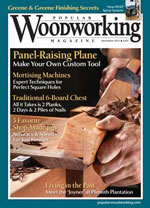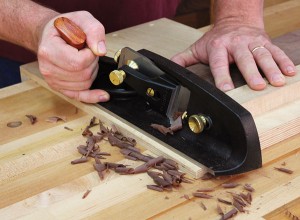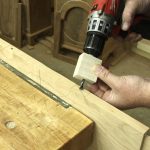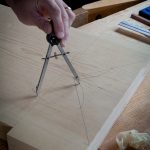We may receive a commission when you use our affiliate links. However, this does not impact our recommendations.
Just as with all the planes Veritas produces, its shooting plane is sleek, well thought-out and ready to tackle the toughest jobs.
With a weight of 7.7 pounds, the Veritas shooting plane gathers momentum quickly and slices through the end grain of even the most rock-hard exotics. But despite its heft, it’s easy to use for extended periods of time because it runs on a shooting board – there is no lifting.
To put the plane through its paces, I decided to use it as it came from the box. The tool I tested had a PM-V11 blade (it’s also available with an O1 blade). It was sharp and ready to work – though a quick honing would have made it even better (which is typical for any new edge tool). The cutting edge has held up well, even after extensive use.
The plane can be used with any shooting board design. The skewed iron helps keep the plane tight against the bed and fence of your shooting board, and the result is increased accuracy and less tear-out.
One thing I appreciate about this tool are the many adjustable features – you can dial it in to suit your work. The throat is fully adjustable, the lock is easy to use and the Norris-style adjuster makes it a breeze to set the iron parallel to the mouth. Well-placed set screws keep the iron in proper adjustment relative to the plane body.
The handle is also adjustable, so you can use the plane both in a chute or as a jointer plane. That’s a great feature – though I would prefer the handle to be a little less blocky; I like to grip curves.
The Veritas shooting plane is available in both left- and right-handed versions. If you need a tool that can shoot your saw cuts to perfection, it’s an excellent choice.
Web Site: Visit the Lee Valley web site.
From the November 2013 issue #206

Here are some supplies and tools we find essential in our everyday work around the shop. We may receive a commission from sales referred by our links; however, we have carefully selected these products for their usefulness and quality.











Charles,
As you do, I admire LV and Veritas for their commitment to innovation in design and quality in execution. They make some of the best hand tools on the market. Also like you, my biggest complaint with the Veritas planes is an aesthetic one: I am underwhelmed by the totes they use on their planes. In this case, the swooshing curves of the steel body of the Veritas shooting plane really accentuate the homeliness of the tote. Otherwise, as you describe, this plane has several outstanding features, especially the PMV-11 steel.
One thing I take issue with is your statement that “the plane can be used with any shooting board design.” My experience is different from yours.
The chiral asymmetry of the plane design drastically limits its usefulness as a miter shooting plane. For many years, I have used my low angle jack plane with a miter shooting board adapted from a design popularised by Robert Wearing and Chris Knight. This shooting board design is especially useful for shooting miters in deep picture frames. The Veritas shooting plane will not work with this design.
To see the miter shoot design similar to that I am referring to: http://www.cornishworkshop.co.uk/album/albums/userpics/10001/Shooting_Board_5.jpg
Another, very effective miter shooting board is the improved design suggested by Don McConnell, and published in Popular Woodworking’s “Handtool Essentials”. This design has the miter block let into a fitted housing in the body of the ramp of the shooting board, constructed such that the grain of the miter block is parallel to the grain of the ramp. The Veritas shooting plane will work with this miter shooting board in one direction, but not in the other.
I am working on an adaptation of the McConnell miter shooting board that will accommodate the Veritas shooting plane, so that I can take advantage of the plane’s excellent features. In this adaptation, the guide track for the plane basically bisects the miter block; that is, support blocks for the mitered piece are on both sides of a central guide track. The plane is pushed from right to left to trim one end of a mitered stick, and left to right to trim the other end.
I would be interested in hearing from others who have used the new Veritas shooting plane to trim miters. I am especially interested in seeing other designs for miter shooting boards that will accommodate this excellent plane. Just to be clear, I am not interested in using the “donkey’s ear” design, because it is impractical for the type of mitering that interests me: picture frames, many of which may range from 4-6 feet in length up to nearly 10 feet. A donkey’s ear will make you feel like a horse’s patootie if you try to use it on such long pieces.